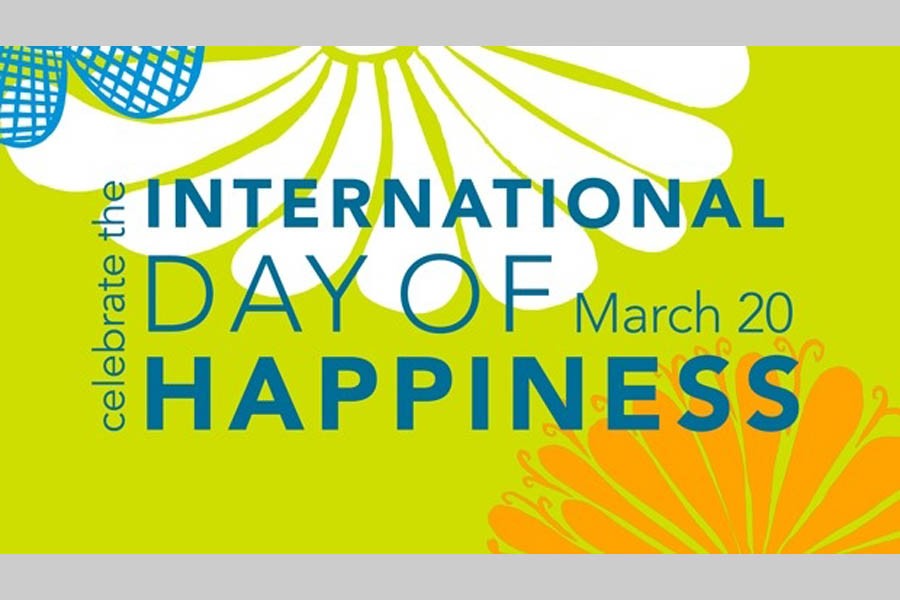Is happiness measurable? Even an individual does not experience unmixed happiness all the time. Life, after all, is an admixture of laughter and tears where one gets the better of the other at times. When it comes to a nation's happiness, the proposition of getting a measure of it is well-nigh impossible. Yet the United Nations has undertaken since the year 2012 the arduous task of giving a shape to the nebulous and fleeting feeling of quiet contentedness that marks the overall ethos of a nation. It has assigned the Sustainable Development Solutions Network (SDSN), an initiative of the UN, to prepare the World Happiness Report every year since then. Accordingly, nations the world over have been celebrating the International Day of Happiness on March 20 under the aegis of the UN.
Now what has really prompted the UN to earmark a day for celebration of happiness in a world that is far from eliminating hunger, poverty, disparity, ill health, conflicts of varying degrees and types -political, ethnic, communal, religious, national and international? The world has witnessed two world wars and it took 67 years to look into a sublime issue like happiness and that too of the nations across the globe. Is it from a sense of security arising out of the disappearance of the cold war or from a context of competing exertion of influences through trade and military regrouping? Events have moved faster following the Russian military intervention in Afghanistan. The creation of terror organisations like Al Qaeda and Taliban along with US military expeditions in Afghanistan and Iraq has transformed the world beyond recognition. This was followed by what is called Arab Spring but clearly the spring ended prematurely. But it triggered a massive exodus of refugees from Africa and the Middle-east to Europe. Yemen and Syria still remain hot spots.
Terror threat loomed large on the only super power following the 9/11 Al Qaeda attack on the US Trade Centre and the Pentagon in 2001. Recruitment of militants for terror groups and export of its theories to other countries were hardly congenial to living in peace let alone happily. Whether the idea of celebrating happiness came from such a fear of the rising activities of terrorism needs to be looked into. One thing is sure that conventional religious interpretations did not prove to be a deterrent to the popularity of terrorism among a section of the young generation.
If the UN has undertaken the onerous task of spreading the message of peace and happiness against violence, it surely had to proceed in an unassuming manner. The fact is that the world body has no power to impose its will on any nations. When sectarian or political violence in conflict-ridden small countries makes life of common citizens wretched, it can only send peace missions there to maintain status quo. But when powerful nations opt for armed intervention or even annexation of parts of another country, it stands a silent spectator. All such developments are no indicators that nations are living a tolerably violence-free life.
Yet it must be admitted that the majority of countries could indeed keep them apart from widespread social, political and armed conflicts. Even in the face of blatant provocation a few maintained their composure -albeit at the risk of enormous pressure on their meagre resources. That Bangladesh has allowed 1.0 million Rohingya refugees to settle in its territory for months is one such example. The refugee exodus -whether it is from Syria, Libya or Rakhine province of Myanmar or Latin America -brings to the fore that a lot of inhabitants on this planet are in extreme agony and are in no mood to stay in the countries they have known their own. Let alone the unstable societies, even in stable societies people want to migrate to their chosen countries for a better life. Is this a sign of happy countries?
The SDSN however has developed six variables that support well-being, income, freedom, trust, healthy life expectancy, social support and generosity. On the basis of these issues, 156 countries have been ranked in the sixth edition of the World Happiness Report 2018. There is no reason that the evaluation will truly reflect what is called happiness in its totality. But a rough idea of the life a people lead in general can be obtained. The Nordic countries have always been at the top of the list. This year is no exception.
Although, it is claimed that money or income has nothing to do with happy life, it is clear from the ranking that money is a prerequisite for mundane happiness. It may be different for spiritual persons who seek happiness beyond this mortal world. All the Nordic countries have a high level of per capita income. Qatar ranks number one in terms of per capita income but surely that country's social indicators are poorer compared to those countries. Singapore with high per capita income also ranks higher because of the country's organised social services.
True, Nordic societies draw their strength from social support system and their fellow feeling -the feeling of empathy. All this is possible because the population sizes are small there. In countries like Bangladesh teeming with people in a small geographic boundary, people have soft hearts too. But when it comes to resource availability, the yawning discrimination does not help the cause. No wonder, the country ranks 115th -five notches below last year's but still it is ahead of Sri Lanka and India. This offers some consolation, no doubt.


